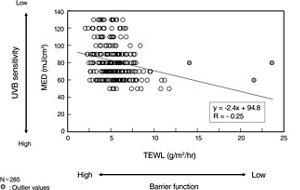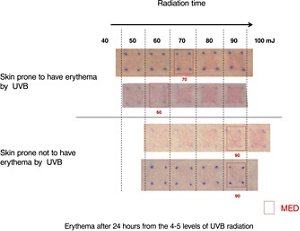Effect of the stratum corneum barrier function on cutaneous photosensitivity (UVB):
Relationship between trans-epidermal water loss and the minimum erythema dose
As part of its ongoing research of healthy and beautiful skin, the Kao Corporation (President: Michitaka Sawada) Biological Science Laboratories and Skin Care Products Research Laboratories found that skin with a reduced cutaneous (stratum corneum) barrier function is prone to UVB-induced irritation. This result suggests that the barrier function of the stratum corneum, the skin component that protects against the penetration of foreign substances, may also protect the skin from ultraviolet irradiation.

Figure 1
Correlation between TEWL (transepidermal water loss) values and MED (UVB sensitivity evaluated by minimum erythema dose)
This research result was published in the journal Photodermatology, Photoimmunology, and Photomedicine in May 2019*1 .
-
* 1 Takagi Y, Mori K, Taguchi H, Nishizaka T, Takema Y., 'UVB sensitivity correlates with cutaneous barrier function in the skin of Japanese females'
Photodermatol Photoimmunol Photomed. 2019 Mar 25. doi: 10.1111/phpp.12467
Background
The cutaneous barrier function prevents the invasion of various external stimuli into the body while protecting the skin against moisture loss.
While people with atopic dermatitis and skin sensitive to stimuli are generally aware that their cutaneous barrier function is low, people with healthy skin tend to know less about this function. Recent research has demonstrated that the transdermal invasion of foreign substances is a greater cause of allergic diseases than oral intake. Findings have further shown that skincare (barrier care) during infancy helps prevent the development of allergies later in life. The role of the cutaneous barrier function has thus been receiving growing attention over the past years.
Kao has been among the first to investigate the cutaneous barrier function of the stratum corneum. Collaborative research by Kao and the Tokyo Women's Medical University has identified decreased levels of intercellular lipids, especially ceramides, in the stratum corneum of patients with atopic dermatitis*2 .
-
* 2 Imokawa G, Abe A, Jin K, Higaki Y, Kawashima M, Hidano A.: "Decreased level of ceramides in stratum corneum of atopic dermatitis: an etiologic factor in atopic dry skin?", J Invest Dermatol. 1991 96: 523-6.
The outline of research
In November 2010 Kao researchers analyzed the skin color and cutaneous barrier function of 285 healthy Japanese female volunteers (age 30 to 49 years old, average: 39.6±5.2 years old). The researchers measured the amount of water lost via the skin (trans-epidermal water loss, TEWL) and assessed skin sensitivity against UVB by determining the lowest UVB irradiating dose to induce erythema (minimum erythema dose, MED).
Darker skin is generally thought to be less prone to sunburn. The analysis, however, indicated that skin sensitivity against UV was negatively correlated not with skin color, but with the cutaneous barrier function (Figure 1). The negative correlation between UV sensitivity and the cutaneous barrier function was significant, and was reproduced twice in more than 250 female volunteers.
Outlook
This research showed that skin with a reduced stratum corneum barrier function is prone to UVB-induced erythema. A person with a low cutaneous barrier function can thus be assumed to be more susceptible to UVB damage. Conversely, a person who is easily sunburned by UVB may have a low cutaneous barrier function. The findings suggest that persons with low barrier function or high susceptibility to UVB sunburn should carefully administer skin care to reinforce their cutaneous barrier function and protect their skin against UVB irradiation.
Kao is going to use these findings in its ongoing search for novel sun protection technologies for skin with low barrier function and high sensitivity, as well as technologies to improve the barrier function in all types of skin. The company continues to research new ways to keep the skin healthy and beautiful under all environmental conditions, including strong sunshine.
【MED:Minimal Erythema Dose】

An index for the sensitivity against UVB evaluated from erythema induced by UVB radiation. MED is the shortest exposure to UVB that produces slight reddening on more than 2/3 of the radiated skin area after 16-24 hours and expressed by radiation energy (mJ/c㎡).
About Kao
Kao creates high-value-added products that enrich the lives of consumers around the world. Through its portfolio of over 20 leading brands such as Attack, Bioré, Goldwell, Jergens, John Frieda, Kanebo, Laurier, Merries and Molton Brown, Kao is part of the everyday lives of people in Asia, Oceania, North America and Europe. Combined with its chemical division, which contributes to a wide range of industries, Kao generates about 1,500 billion yen in annual sales. Kao employs about 33,000 people worldwide and has 130 years of history in innovation. Please visit the Kao Group website for updated information.
Media inquiries should be directed to:
Corporate Communications
Kao Corporation
